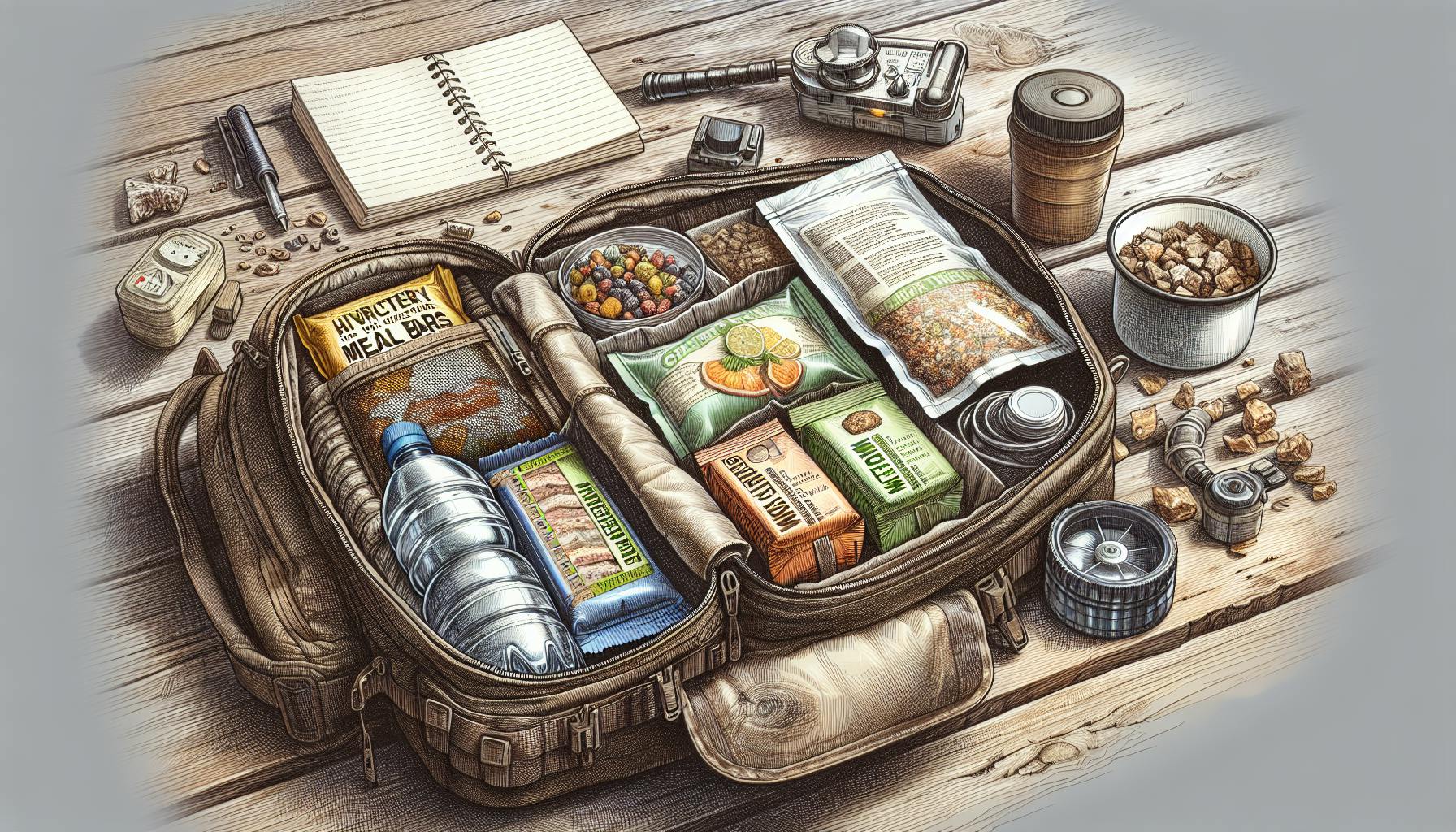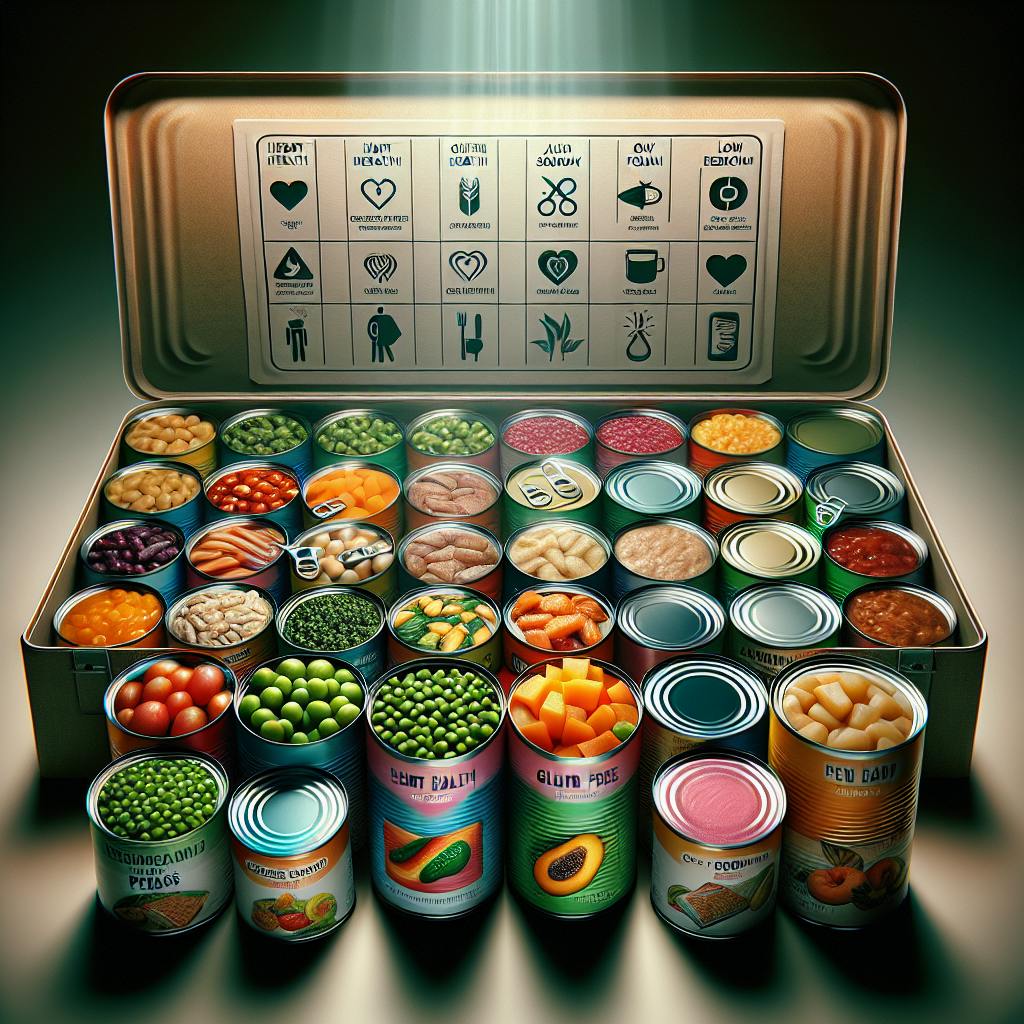Selecting nutritious, long-lasting foods is crucial for emergency preparedness, but it can be overwhelming to know where to start.
This article will provide clear guidance on wise survival food selection for long-term storage, focusing on nutritional value, shelf life, and ease of preparation.
You'll learn the best foods to stockpile, storage tips, how to calculate needs for your family, and specialty considerations like organic and dietary restriction options.
Introduction to Wise Survival Food Selection
Choosing the right survival food is crucial to being prepared for emergencies. When selecting wise options for your food storage, there are a few key criteria to consider:
Understanding the Importance of Nutritional Value in Survival Foods
It's important to calculate your daily nutritional needs and choose foods that will meet those requirements in an emergency situation. Prioritize foods that provide calories, protein, vitamins, and minerals. Having foods with enough nutritional value will help support health and prevent deficiency diseases.
Maximizing Shelf Life for Long-Term Storage
Look for survival foods with longer shelf lives, ideally 20+ years, to ensure freshness even when stored for extended periods. Options like freeze-dried and dehydrated foods have very long shelf lives compared to canned goods. Properly storing foods can also help maximize shelf life over decades.
The Ease of Preparation: A Crucial Factor in Survival Situations
In survival scenarios, resources like cooking fuel may be limited, so choose foods that are very easy to prepare. Wise dehydrated and freeze-dried meals only require adding hot water, making them convenient options requiring minimal energy and effort.
Strategic Storage Conditions for Optimal Preservation
Storing survival foods properly by temperature, moisture control, and containment method helps preserve nutritional value and freshness long-term. Consider cool, dark spaces for storage. Oxygen absorbers and sealed containers prevent moisture issues. Apply these storage strategies for 25+ year shelf lives.
By evaluating survival food by nutritional content, shelf life, ease of preparation, and ideal storage conditions, you can make informed choices to create an emergency food supply that will remain fresh and nutritious for decades to come.
What do you need to survive food wise?
When building your emergency food supply, focusing on shelf-stable foods that provide nutritional value is key. Here are some tips for choosing wise survival foods:
Canned and Dried Goods
Stock up on ready-to-eat canned meats, fruits, vegetables, and beans. Be sure to get a manual can opener as well. Other good options are:
- Protein or fruit bars
- Dry cereal, granola, oats
- Peanut butter
- Dried fruits and nuts
- Canned juices and milk
- Pasta, rice, quinoa
Nutrient Density
Prioritize foods that offer protein, healthy fats, fiber, vitamins, and minerals. Things like beans, lentils, nuts, seeds, and some whole grains fit the bill.
Long Shelf Life
Look for non-perishable foods that have a shelf life of at least 5 years. Some examples are wheat berries, rice, honey, salt, vegetable oils.
Ease of Preparation
Choose foods that require minimal preparation like crackers, jerky, and trail mix. But do stock up on fuel sources like propane tanks, charcoal, or wood pellets to enable cooking if needed.
Having the right emergency food supplies on hand will provide sustenance and peace of mind when facing unexpected events. Focus on nutrient-dense foods with long shelf lives and minimal prep needs.
How long does wise survival food last?
Wise Company offers high-quality survival food with an exceptionally long shelf life. Their foods are designed for long-term emergency preparedness and can last up to 25 years when stored properly.
Here are some key factors that contribute to the long shelf life of Wise survival foods:
- Careful ingredient selection - Wise chooses ingredients like freeze-dried vegetables, fruits, meats and grains that retain nutrients and taste for decades. These ingredients are gently processed to remove moisture which is what causes food spoilage over time.
- High-quality packaging - Wise packages their foods in thick, durable mylar pouches that block oxygen and light. This prevents oxidation and preserves freshness. The pouches are then packed into sturdy plastic buckets for further protection.
- Ideal storage conditions - Storing Wise foods in a cool, dark place around 55-70°F allows them to achieve a shelf life of 25 years. Wise foods can still last 10-12 years in less than ideal conditions like temperature fluctuations.
The extreme shelf stability of Wise foods makes them perfect for emergency preparedness. You can store them for decades and still have nutritious, appetizing meals ready when you need them. Following the recommended storage guidelines optimizes shelf life.
So in summary, thanks to carefully chosen ingredients, high-quality packaging and ideal storage conditions, Wise Company emergency foods can realistically last 25 years or more - giving you long-lasting peace of mind.
What is the best food to eat to survive?
When choosing the best survival foods, it's important to consider nutritional value, shelf life, and ease of preparation. Some top options include:
- Beans and legumes like lentils, chickpeas, and black beans. These are packed with protein, fiber, and key nutrients. Canned or dried beans have a long shelf life.
- Whole grains such as brown rice, oats, and quinoa. These provide complex carbs for energy along with vitamins and minerals. They store well long-term when properly packaged.
- Canned fish like salmon, tuna, sardines, and mackerel. Canned seafood is rich in protein and healthy omega-3 fatty acids. It lasts 2-5 years in storage.
- Eggs can be preserved through powdered egg products with a shelf life of 2-10 years. They are an excellent source of protein.
- Freeze-dried or dehydrated meats like beef, chicken, and turkey. These maintain their nutritional value and can last decades when stored properly.
When building your emergency food supply, be sure to stock up on versatile ingredients that provide balanced nutrition. Also prioritize items with longer shelf lives that will sustain your family through an extended crisis.
What food should be stockpiled?
When building your emergency food supply, focus on nutrient-dense foods with a long shelf life. Some good options to stockpile include:
Canned and Dried Goods
- Canned meats like chicken, tuna, salmon, and beef stew provide protein. Choose low-sodium options.
- Canned beans, vegetables, and fruits offer fiber, vitamins, and minerals. Go for fruit canned in juice rather than syrup.
- Whole grains like rice, quinoa, pasta, and oats stored in airtight containers are versatile carbs.
- Dried beans and lentils are affordable sources of plant-based protein and fiber.
Dairy and Protein Powder
- Powdered milk lasts longer than shelf-stable milk boxes or cans. Reconstitute before use.
- Whey and plant-based protein powders add nutrition. Choose unflavored for versatility.
When stocking up on survival food, focus on nutrient density, not just calories. Select wholesome, minimally processed options whenever possible for the healthiest emergency food supply. Integrating some organic emergency food options can help avoid potentially harmful pesticides or preservatives as well.
sbb-itb-b932644
Establishing a Best Emergency Food Supply
When building a long-term emergency food supply, it's important to have a balanced mix of nutritious foods across key groups like fruits, vegetables, grains, proteins, and fats. This will help meet nutritional needs in an emergency situation.
Selecting Canned and Jarred Produce for Extended Shelf Life
Canned and jarred fruits and vegetables are great for emergency food storage because of their long shelf life. When stocking up, prioritize nutrient-dense options like tomatoes, green beans, carrots, and fruit packed in juice rather than syrup. Avoid added sugars or sodium. Store cans in a cool, dark place and check expiration dates regularly.
Storing Whole Grains and Legumes for Longevity
Whole grains like brown rice, quinoa, and oats are nutritious emergency food staples that store well long-term if kept dry and sealed. Dried Emergency Food Beans are also essential for protein and fiber. Store in airtight containers and use oxygen absorbers to prevent spoilage. White rice and beans make a complete protein pairing.
Incorporating Nuts, Seeds, and Nut Butters into Your Survival Diet
Nuts, seeds, and nut butters pack a nutritional punch thanks to healthy fats, plant-based protein, fiber, vitamins, and minerals. Their high calorie density helps meet energy needs in an emergency. Prioritize unsalted options to avoid sodium overload. Vacuum seal or store in the refrigerator after opening.
The Role of Dried and Freeze-Dried Meats in a Balanced Emergency Food Supply
Dried and freeze-dried meats like jerky or Wise Dehydrated Food retain more nutrients than canned options. They offer lean protein for energy requirements and can be stored long-term if properly sealed. Rotate stock every few years for maximum freshness. Reconstitute with hot water before eating.
Planning for a 25-Year Emergency Food Supply
When preparing for long-term emergencies, having an adequate food supply is critical. By calculating your family's nutritional needs and creating a balanced inventory with a focus on shelf life, you can assemble a resilient 25-year stockpile tailored to your household.
Calculating Long-Term Food Requirements for Your Family
- Determine total daily calories needed for each family member based on age, gender, activity level
- Account for any special dietary needs or restrictions
- Use recommended daily intake guidelines for nutrients like protein, carbs, fat
- Calculate portion sizes and quantities needed to meet caloric and nutritional needs over time
- Allow for extra supply as a buffer and to account for increased activity/caloric expenditure in an emergency
Creating a Balanced and Nutritious Food Inventory
- Include variety of foods like grains, legumes, nuts, dried fruits and vegetables
- Incorporate wise survival food options with long shelf life like dehydrated and freeze dried meals
- Store nutrient dense foods like oats, brown rice, beans, lentils, quinoa
- Consider comfort foods like soups, pasta, and sweet treats for morale
- Utilize mylar bags and oxygen absorbers to extend shelf life dramatically
Utilizing Mylar Bags for Enhanced Food Preservation
- Mylar bags create an air-tight barrier that protects against oxygen, moisture and insects
- Pair with oxygen absorbers to remove oxygen and inhibit food spoilage
- Allows storage of dry goods like grains, beans, nuts for 20-30 years
- Properly sealed mylar bags prevent infestation from pests
- Use high quality thick mylar rated for long term food storage
Best Practices for Cycling and Refreshing Your Food Supply
- Date and organize storage containers for easy inventory tracking
- Establish a first-in, first-out system to cycle older food into regular meals
- Inspect bags periodically and replace any that are damaged
- Test older items for quality and refresh any that are expired or spoiled
- Gradually use and replace food over time to keep inventory aligned to needs
Storing a resilient 25-year emergency food supply requires careful planning, balanced nutrition, and proper storage methods. Following these best practices for calculating needs, creating inventory, utilizing mylar bags, and managing your stockpile can set your family up for self-reliance in the long run.
Tailoring an Emergency Food Supply for a Family of 4
When preparing an emergency food supply for a family, it's important to have a variety of nutrient-dense foods with a long shelf life.
Choosing Wise Dehydrated and Freeze-Dried Meals for Convenience
Wise Company offers a wide selection of ready-to-eat meals with a 25-year shelf life. Their dehydrated and freeze-dried entrees, sides, and breakfasts only require hot water for preparation, making them extremely convenient in an emergency when cooking fuel or appliances may not be available. Some top picks include:
- Emergency Food Breakfast Buckets - Just add hot water to the dehydrated scrambled eggs, breakfast skillets, cereal, and more.
- Emergency Food Entrees - Selections like creamy potato soup, cheesy broccoli rice, and chicken teriyaki with rice.
- Emergency Food Sides - Dehydrated favorites like mashed potatoes, green beans, and mac & cheese.
Investing in Wise Company Emergency Food Buckets
Wise offers pre-packaged emergency food buckets with up to 104 servings of meals, meats, fruits and vegetables per pail. A good selection for a family of 4 might include:
- Breakfast and Entree Combo - 44 servings of breakfasts, lunches, and dinners.
- Meat Variety Bucket - 32 servings of chicken, beef, and pork.
- Fruit and Veggie Bucket - 64 servings of apples, carrots, green beans, and more.
Stocking Up on Wise Powdered Eggs and Milk for Essential Proteins
Having a supply of dried eggs and milk allows you to bake and make protein shakes. Wise's rehydratable whole egg and instant milk powders have a 15-30 year shelf life. Stock up on several cans of each to cover your family's needs.
Adding Wise Freeze-Dried Produce for Nutrient-Rich Options
Wise Company offers individual pouches of freeze-dried fruits and vegetables that retain their flavor, texture, and nutrients with a 25+ year shelf life. They provide essential vitamins and minerals, adding nutrition variety. Good options include strawberries, blueberries, peaches, green beans, broccoli, and carrots.
Having a diverse stockpile of emergency food tailored to your family's tastes and needs is key to being prepared. Investing in products with proven long shelf lives from reliable brands like Wise ensures you'll have reliable, nutritious options when you need them most.
Opting for Organic and Special Dietary Emergency Foods
Organic and specialty dietary emergency foods can provide important health and sustainability benefits for your survival preparedness. When building your emergency food supply, consider the following aspects.
The Benefits of Organic Emergency Food for Health and Safety
Choosing organic emergency food options offers both nutritional and environmental advantages:
- Organic foods avoid potentially harmful pesticides and chemicals used in conventional farming. This reduces your exposure to toxins when relying on your emergency food supply.
- Organic production methods promote soil health and water conservation, aligning with eco-friendly values.
- USDA certified organic foods adhere to strict guidelines, giving you confidence in the quality of ingredients. Look for the USDA organic seal when shopping.
Navigating the Market for Organic Emergency Food Choices
You can find high-quality organic emergency food options to meet various needs:
- Seek out brands that focus specifically on organic, non-GMO survival food with long 25+ year shelf lives.
- For vegetarian or vegan supplies, choose plant-based proteins like organic beans, lentils, and nut butters.
- Accommodate gluten-free diets with organic whole grains like quinoa and amaranth.
- Compare nutritional labels to pick items dense in nutrients, vitamins, minerals, and antioxidants.
Special Considerations for Dietary Restrictions in Emergency Planning
If you or family members follow special diets, factor those needs into your emergency plans:
- Stock additional specialty items like dairy and egg replacements to cover restricted ingredients.
- Ensure variety across food groups - fruits, vegetables, grains, protein, etc.
- Rotate specialty products more frequently to use within shelf life. Write expiration dates clearly on containers.
Maintaining Variety and Taste with Organic Emergency Food Selections
Boost morale in emergencies with delicious, nutrient-dense foods:
- Seek out tasty freeze-dried and dehydrated ingredients to add comfort and normalcy.
- Mix up textures with crunchy nuts, chewy fruit leathers, smooth nut butters.
- Blend familiar comfort recipes and international flavors for excitement.
Prioritizing health and sustainability with organic emergency supplies pays dividends for readiness and peace of mind. Evaluate options carefully to find the best solutions for your household's needs.
Conclusion and Key Takeaways
Building a resilient emergency food supply takes forethought and planning, but is critical for preparedness. When selecting survival foods, prioritize options with long shelf lives, nutritional diversity, ease of preparation, and proper storage to maximize freshness over time.
Brands like Wise offer tasty, reliable options for a complete 25-year food supply. By taking a phased approach, you can slowly build up your reserves until you have a diverse and robust stockpile tailored to your family's unique needs.
Summarizing the Essentials of a Wise Survival Food Strategy
The foundation of any emergency food strategy should be nutritional completeness across all key food groups. Daily targets for calories, macronutrients, vitamins, and minerals should be met to support health. Wise foods check these boxes with offerings like:
- Breakfast blends with eggs, grains, fruit
- Entrée kits with meat, beans, rice, veggies
- Freeze-dried fruits and vegetables
- Dairy items like milk and butter powder
This nutritional diversity ensures your food supply will keep you energized and healthy for the long haul.
Emphasizing the Importance of a Phased Approach to Food Storage
Building a 25-year supply may seem daunting. By taking it step-by-step, you can make steady progress without breaking the bank:
- Start with a 1-month supply, then expand to 3 months after saving up.
- Build up key staples like rice, beans, oats first before specialty foods.
- Set a goal to add 3 more months of food each year.
- Rotate stock by eating oldest food first and replacing items that expire.
With some patience and savvy budgeting, you'll have reliable long-term reserves before you know it.
Reiterating the Best Practices for Storing Survival Food
To maximize shelf life, be meticulous about storage:
- Use food-grade plastic buckets with gasket lids for containment. Add oxygen absorbers.
- Store in cool, dark place like basement around 55-70°F. Avoid temperature fluctuations.
- Keep area dry with less than 70% humidity. Use desiccants if needed.
- Inspect buckets every 6 months for pests or moisture issues.
Follow guidelines carefully and even "best by" dates can be extended by years. Proper storage lets you depend on your food supply when you need it most.


